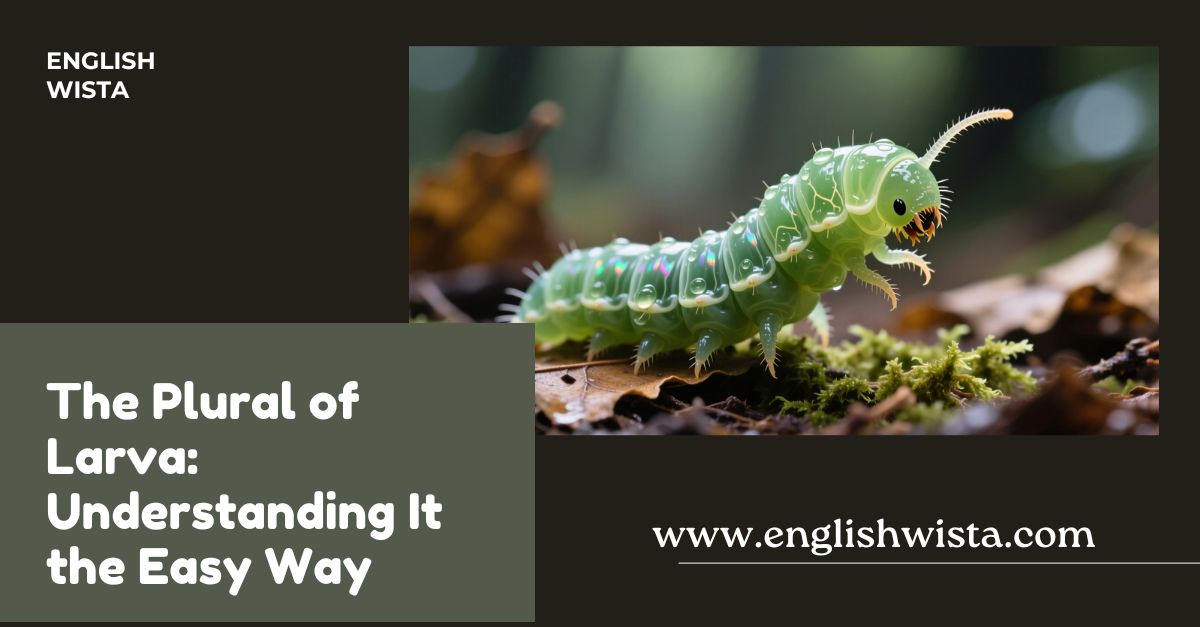Have you ever watched a butterfly fluttering by and wondered what it looked like before it grew wings? Believe it or not, that beautiful insect started as something much simpler a larva! The word larva may sound a little scientific, but it actually pops up more often than you’d think, especially when we talk about insects, amphibians, or other creatures that go through metamorphosis.
Now, here’s a question that often confuses people what’s the plural of larva? Is it larvas? Or something else entirely? Don’t worry, you’re not alone in wondering! English can be a bit tricky when it borrows words from Latin, and larva happens to be one of those words.
In this article, we’ll break it all down in plain, friendly English. You’ll learn what larva means, how to form its plural, how to use both words in sentences, and even pick up a few fun facts along the way. So, let’s take a closer look!
What Does “Larva” Mean?
Before we talk about plurals, let’s start with the basics.
A larva is the early form of an animal that looks very different from its adult stage. You’ll find larvae (yes, that’s the plural, but more on that soon!) in creatures like butterflies, beetles, frogs, and even some sea animals.
For example:
- A caterpillar is the larva of a butterfly.
- A tadpole is the larva of a frog.
In simple words, a larva is like a baby form that still has to grow and change before becoming a full-grown adult.
What Is the Plural of Larva?
Here’s the main question what’s the correct plural form of larva?
The answer is larvae (pronounced LAR-vee or sometimes LAR-vai).
So:
- Singular: larva
- Plural: larvae
That means when you’re talking about just one, you say a larva.
But when you’re talking about more than one, you say larvae.
For example:
- The larva of a mosquito lives in water.
- The larvae of mosquitoes can be seen wriggling in puddles after rain.
See the difference? Just one little letter changes, but it changes the whole meaning!
Why Isn’t the Plural “Larvas”?
That’s a great question! Many English words form their plural by adding “-s” or “-es.” So naturally, people wonder why larva doesn’t become larvas.
Here’s the reason: Larva comes from Latin, and English has borrowed many scientific words from that language. In Latin, nouns ending in -a often change to -ae when pluralized.
Here are a few examples:
- alga → algae
- formula → formulae (though formulas is also accepted in modern English)
- antenna → antennae (used in biology for insects, but antennas for TV or radio)
- larva → larvae
So, larvae follows the traditional Latin plural pattern.
However, it’s worth noting that larvas can sometimes appear in informal writing, especially in non-scientific contexts. Still, if you want to be correct and sound knowledgeable, larvae is the form you should use.
How Do You Pronounce “Larvae”?
Good question because this one trips people up often!
You can pronounce larvae in two ways, and both are correct:
- LAR-vee (common in American English)
- LAR-vai (common in British English and scientific contexts)
So whether you say LAR-vee or LAR-vai, you’re saying it right!
Using “Larva” and “Larvae” in Sentences
Let’s look at how these words appear in real sentences. Reading examples helps your ear get used to the difference between singular and plural.
Examples with Larva (singular):
- The larva of a butterfly feeds on leaves before forming a chrysalis.
- A mosquito larva can grow quickly in standing water.
- Each larva will eventually transform into an adult insect.
Examples with Larvae (plural):
- The larvae of beetles burrow into the soil to feed on roots.
- Scientists observed the fish larvae under a microscope.
- Frog larvae, also called tadpoles, live in water before growing legs.
Notice how the plural larvae fits naturally when you’re describing more than one creature in its early stage.
Is “Larvae” a Countable Noun?
Yes, it is! You can count larvae just like you count other living things.
For example:
- One larva, two larvae, three larvae.
You wouldn’t say “some larva” if you mean more than one. Instead, you’d say “some larvae.”
Examples:
- There are many larvae in the pond.
- The scientist collected three larvae for observation.
Where Do You Find Larvae in Nature?
Now that you know the grammar, let’s add a little biology fun!
Larvae appear in many parts of the natural world. Depending on the species, larvae might look, live, and behave very differently from their adult forms.
Here are a few examples:
- Butterflies and moths: Their larvae are caterpillars that munch on leaves.
- Frogs: Their larvae, called tadpoles, swim in ponds before developing legs.
- Beetles: Many have white, worm-like larvae that live underground.
- Mosquitoes: Their larvae wriggle in water before turning into flying insects.
Pretty amazing, right? The next time you spot a little creature crawling or swimming around, you might be looking at a larva in action!
Etymology: Where Did the Word “Larva” Come From?
Here’s a fascinating fact larva has a spooky origin!
The word larva originally came from Latin, where it meant ghost or mask. The ancient Romans used it to describe spirits or hidden forms. Later, scientists borrowed the term because a larva “hides” the true form of the adult animal beneath its early stage like a mask that conceals its final appearance.
That’s quite poetic, isn’t it? A larva is like a ghost of what’s to come a living mask waiting to transform.
Larvae in Science and Everyday Life
You might think larvae only belong in science labs, but they’re part of our daily world too.
For example:
- In agriculture: Farmers study insect larvae to protect crops from pests.
- In ecology: Larvae play important roles in food chains, feeding birds, fish, and other animals.
- In medicine: Maggot therapy (using fly larvae) helps clean infected wounds by eating dead tissue a method still used in modern hospitals!
So, while the word larva might sound small, its impact on nature and even human life is quite big.
Common Mistakes to Avoid
When learning the plural of larva, people often make a few predictable mistakes. Let’s clear them up:
- Using “larvas” instead of “larvae.”
❌ Incorrect: The larvas were swimming in the pond.
✅ Correct: The larvae were swimming in the pond. - Using “larvae” for singular.
❌ Incorrect: A larvae was crawling on the leaf.
✅ Correct: A larva was crawling on the leaf. - Spelling confusion.
Remember, larva ends with “-va,” not “-ver” or “-var.” And larvae ends with “-vae,” not “-via.”
Keeping these small details in mind will make your writing sound much more polished.
Similar Words and Patterns
Once you understand larva → larvae, you’ll start noticing similar words that follow the same Latin rule.
Here are a few examples for comparison:
| Singular | Plural | Meaning |
|---|---|---|
| alga | algae | Simple plant-like organism found in water |
| antenna | antennae | Sensory appendages on insects |
| formula | formulae | Mathematical or chemical expressions (though formulas is also fine) |
| vertebra | vertebrae | Bones forming the spine |
| larva | larvae | Early life stage of an animal |
Seeing this pattern helps you recognize how Latin-based words behave in English.
Fun Facts About Larvae
Here are some fun and surprising facts to make you appreciate these little creatures even more:
- Transformers of Nature: A larva can completely change its shape, diet, and lifestyle when it becomes an adult. That process is called metamorphosis.
- Some Never Grow Up: Not all larvae transform! Some stay in their larval form for years or even their entire lives.
- Light Eaters: Certain marine larvae actually use sunlight to grow, just like plants!
- The Fast Growers: Insects like flies can grow from egg to adult in just a few days, with larvae doubling their size several times before pupating.
Nature really is full of wonders.
Quick Recap: Key Takeaways
Let’s sum it all up so you can remember it easily:
- Larva means the early stage of an animal that changes as it matures.
- The plural of larva is larvae (not larvas).
- Pronounce it LAR-vee or LAR-vai both are correct.
- Use larva for one and larvae for more than one.
- The word comes from Latin, meaning ghost or mask.
- You’ll find larvae everywhere from your garden to the ocean!
Conclusion: Small Word, Big Transformation
Now you know everything you need about the plural of larva! It’s not just a grammar point it’s a peek into nature, language, and even a little history.
Next time you see a caterpillar crawling on a leaf or a tadpole swimming in a pond, you’ll know you’re looking at a larva. And if you see many of them together, you can confidently say, “Look at all those larvae!”
Language, like nature, is full of transformations. Just as a larva becomes a butterfly, a single word can grow into a world of meaning once you understand its roots.
So go ahead use larva and larvae with confidence. You’ve got it mastered now!



